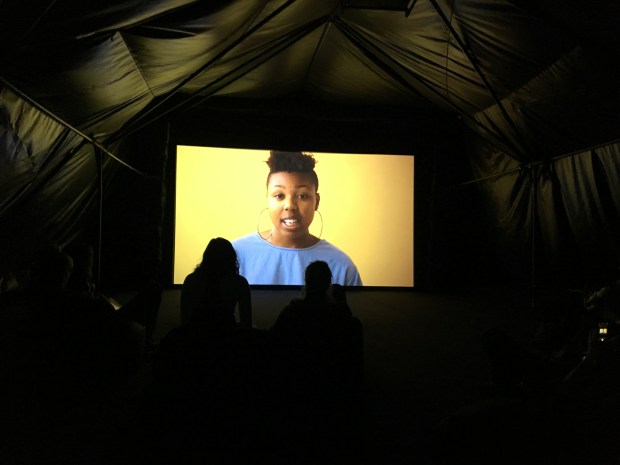Arthur Jafa at Store Studios

Perhaps you’ve already seen Soul of a Nation: Art in the Age of Black Power at Tate Modern. If you haven’t, you should. It’s full of marvellous things, from the paintings of Romare Bearden, Wadsworth Jarrell and Bob Thompson to the photographs of Roy DeCarava and Beuford Smith via posters and murals and a vitrine full of covers of The Black Panther newspaper. One or two of the later rooms aren’t so compelling, and I was unpleasantly jarred by the mystifying inclusion of Andy Warhol’s portrait of Muhammad Ali. But the whole exhibition, curated by Mark Godfrey and Zoe Whitley, tells a great story and seethes with life.
On the other side of the Thames, there’s something strongly related. Installed in a black tent-like structure on the roof of Store Studios as part of Everything at Once, a kind of de luxe pop-up show in an old brutalist office building at 180 The Strand, overlooking the Shard and the National Theatre, Arthur Jafa’s Love Is the Message, the Message is Death is very different in nature and scale but, because of its contemporaneity, even more affecting.
This is a seven-minute collage of snippets of film from all kinds of sources, set to Kanye West’s “Ultralight Beam”. For those, like me, previously unfamiliar with his 30-year career, Jafa is a cinematographer who was born in Mississippi, lives in Los Angeles, has worked with Spike Lee, directed a couple of the videos for Solange’s masterpiece A Seat at the Table in 2016, and exhibited earlier this year at the Serpentine Gallery.
His new work uses newsreel and found film of black Americans marching, worshipping, performing, dancing, and being threatened, beaten and shot by officers of the law. These images are juxtaposed with footage of heroes: Nina and Aretha; Martin and Malcolm; Miles and Trane; Louis and Jimi; the two MJs, Jordan and Jackson; Serena and Lebron; Ali and Louis Farrakhan; and a 17-year-old Biggie Smalls rapping on a Bedford-Stuyvesant streetcorner. Having started with a clip of Barack Obama at the funeral of the murdered Rev. Clementa Pinckney in Charleston, South Carolina, it ends with James Brown in his ’60s prime.
The whole thing has the rawness of a crude assemblage of video grabs. Hardly anything lasts more than a few seconds, an exception being a harrowing sequence of a mother in distress as she’s ordered from her car by police at night and is handcuffed before her young son makes his way towards them with his hands raised. Jafa occasionally intersperses his chosen clips images with close-ups of the sun and footage from monster movies, whose relevance I don’t really understand. (There’s also a curious decision to include the famous clip of Derek Redmond, the British 400-metre runner, limping to the finish of the Olympic semi-final with a torn hamstring, supported by his father, in Barcelona 25 years ago.)
I suppose I could say that Love Is the Message, the Message Is Death doesn’t tell me anything really new, or make me feel any different. But the cumulative power of the collage is moving and shocking, and Kanye West’s spare, gospel-drenched piece provides the perfect musical accompaniment for the emotions evoked by the sometimes beautiful, sometimes brutal images juxtaposed on the screen. In the Observer, the art critic Laura Cumming called it “a devastating ode to black America”, and I can’t do better than that. I watched it through several times without a break, and I expect I’ll go back for more before it disappears.
* Everything at Once, which is organised by the Lisson Gallery and the Vinyl Factory, also includes work by Ai Weiwei, Marina Abramović, Anish Kapoor, Richard Long, Julian Opie and others, and is on until December 10. Soul of a Nation closes on October 22; there’s a CD of music put together by the Soul Jazz label, featuring appropriate music from Don Cherry, Gil Scott-Heron, Joe Henderson and others. There’s a very good interview with Arthur Jafa here, from Interview magazine earlier this year.

Thanks Richard
Sent from my iPhone
>
Thanks for highlighting this. I will try and see it
I too thought that Soul Of A Nation tailed off markedly after the great impact of the first five rooms. I thought only the Betye Saar room of the later ones stood up to the power of those early rooms. If only the entire exhibition had been an expanded version of the early rooms. The room with the Black Panther vitrine (and that brilliant Amiri Baraka portrait) and the corridor room of photography could both have been so much more.
An interesting half hour with the two curators was broadcast yesterday on Gilles Peterson show making the link with music much more explicit.
On an entirely different tack, will you be writing a review of the Vijay Iyer Sextet concert? I’m pretty sure I saw you chatting with Steve Lehman at the end
You did, but I won’t. It was one of those nights I just wanted to enjoy for itself. Might end up at the top of the gigs of the year list. Hope you enjoyed it too. Steve is coming to play at the Berlin festival with Sélébéyone in two weeks’ time.
it would be great to have Lehman perform that, or anything else, in London.
The Iyer sextet left me admiring rather than enjoying a lot of it (I have a similar response to the album). Less than the sum of its undoubtedly very talented parts for me. It was great to hear Graham Haynes live though.
Thanks, Richard, for alerting me to this – Arthur Jafa sounds really interesting…